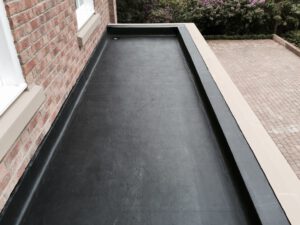There are many different types of rubber roofing, and not all of them are the same. Some are made from polyvinyl chloride (PVC), while others are made from ethylene propylene diene monomer or TPO. Either type will work well for your home, but there are certain things to consider when choosing a rubber roof for your home. Here are some important considerations to keep in mind:

Installing a rubber roof is easier than you may think. Because rubber is so lightweight, it is easier to install than most roofing types. This makes it more cost-effective to install than other types of roofs. However, you should hire licensed roofing professionals like Roofing Contractors to install your new roof. You’ll be glad you did. After all, a good roof is a long-lasting investment. If you’re thinking about replacing your commercial roof soon, consider using a rubber roof.
If you’re considering installing a new rubber roof, know your local climate before you decide which material to choose. EPDM, for example, operates between -40 degrees Fahrenheit and 300 degrees, so it’s suitable for nearly any climate. However, you must remember that EPDM is more expensive than asphalt shingles, and if you’re in an area with frequent hailstorms, choose a thicker membrane. In either case, the best way to protect your home from hailstorms is to get an EPDM roof.
A rubber roof can be installed on sloped or flat roofs, but they’re most effective on flat and low-sloped surfaces. It can last as long as 50 years or more, and fewer seams mean less water seepage. Another benefit of using rubber roofing is that it’s fire-resistant, pest-resistant, and mold and mildew-resistant. It’s made from recycled materials and is easier to install than other types of roofing.
When you’re installing a rubber roof, it’s important to carefully prepare the surface to make sure the rubber membrane will attach to the surface. Make sure to clean the surface of any previous roofing to prevent air bubbles from forming. Afterward, cut the rubber, so it fits and doesn’t fall off. When you’re done, you’re ready to install the roof. You’ll need to prepare the roof deck by removing the previous roofing.
The life expectancy of a rubber roof depends on the type of material used and the installation process. Some materials have lower longevity than others, and some require higher maintenance costs. Taking this into account can help you avoid costly repair bills down the line. Rubber roofs can last up to 50 years, which is impressive considering they require minimal maintenance. Even minor damages, such as cracks or tears, can be repaired using a rubber sealant.
EPDM or ethylene propylene diene monomer is a common type of synthetic rubber. It was developed in the 1960s and is one of the most common types of rubber roofing. EPDM is black, but some companies have a white or grey EPDM option. EPDM seams are sealed with adhesives rather than thermoplastic melding, as is the case with other materials. In addition, EPDM roofs are highly resistant to weather and UV damage and are easy to maintain and repair.
Because rubber roofing is made of synthetic materials, it is flexible and waterproof. It also can reflect heat away from your home, keeping your home cooler. Although you should always strip your roof down to the base before applying a rubber roof, you may lose your warranty if you don’t properly prepare the surface. Depending on the material you use, latex coatings require a thorough cleaning of the surface before applying the finish. So, it’s important to carefully choose a roofer who has the necessary skills and experience to install a rubber roof.
The cost of rubber roofing will vary depending on the size of your home and the pitch and slope of your roof. In addition, the thickness of the rubber roof you choose will be largely dependent on several other factors, including where you live. Talk to a roofing expert at a roofing company. They will not rely on commissions to sell you a product. You can also consult a roofing expert to help you determine the best thickness for your home.
Regular cleaning is vital to the longevity of a rubber roof. Even though the material is extremely durable, the elements can easily chip away at their lifespan. Therefore, it is important to clean your roof at least four times a year to maintain its luster and prevent damage. A professional will also recommend periodic repainting with acrylic paint. Cleaning your rubber roof can extend the life of your roof up to twenty years. In most cases, you should clean your roof at least once every two to three years.